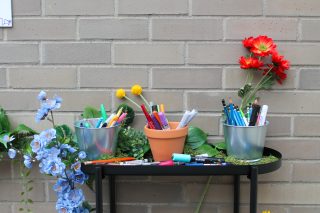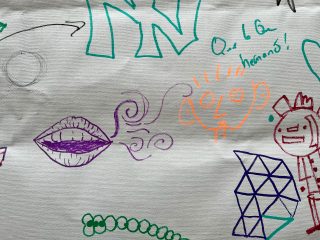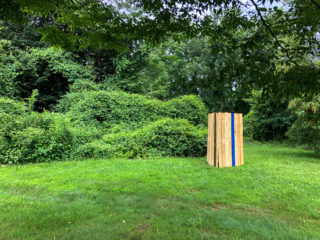
Quicksand disguised as grass gobbled the corner of an empty house on the Rose Kennedy Greenway in Boston. But just as quickly as the earth had opened, it closed like concrete leaving the house lopsided, one side submerged beneath the earth and the other teetering above it.
This is Mark Reigelmän’s The Meeting House, a whimsical public art installation rooted deep in the history of the land that surrounds it. Its New England Quaker-style structure is based on the architecture constructed by Boston’s first colonial settlers. The piece was even fabricated using those same traditional materials and techniques.
Lindsey Davis: A lot of the inspiration for the piece is rooted in Boston’s history, and its role as a haven of religious liberty for colonial settlers. What’s your personal experience or history with religion like, and did it play a role in your inspiration for the piece?
Mark Reigelmän: I spent a portion of my youth as a practicing Protestant and continue to be interested in how religion shapes and manipulates contemporary culture. However, I try to approach each site as objectively as possible in hopes that my personal experiences do not overpower the information offered by each individual part. Boston’s history is so rooted in religion that it is impossible to untangle from the other facets of New England identity that make the region so unique. While my personal experiences with religion may have helped shape the results of the project in some small ways, the real inspiration was offered by the site itself.

LD: What was the process like for bringing this project to life? Did you have to pitch the idea to the Greenway and how long did the process take from initial inspiration to final installation?
MR: Working with the Rose Kennedy Greenway Conservancy and Public Art Curator Lucas Cowan made this project a phenomenal experience. Lucas reached out to me in early 2016 to discuss his curatorial goals, the history of the Greenway and this specific public art opportunity. I was excited to be invited to participate in this dynamic venue, and honored to exhibit work in Boston where brilliant artists such as Ai Weiwei, Lawrence Weiner, Janet Echelman, Matthew Ritchie, Tom Otterness and others have been able to ignite downtown with temporary installations.
I presented Lucas with a Conceptual Proposal with a number of potential explorations and we worked collaboratively to select a direction that we thought would be able to capture the curatorial theme, “Playful Perspectives,” and offer a powerful and memorable experience for passersby. Over the next several months I continued to develop the concept, worked with local historians to better understand the area’s past, explored and analyzed New England architecture and closely collaborated with Master Craftsman, Structural Engineers and Installers. Overall, it took approximately 15 months of a dedicated team of people to realize The Meeting House.

LD: The conservancy’s director told the Boston Globe that your installation is not of the “do-not-touch variety.” Is it really okay for viewers to touch and physically interact with the piece?
MR: Of course! While this installation is not exceptionally interactive, the meticulously fabricated details are certainly worthy of close inspection, the cantilevered entry is ripe with interactive opportunities, and the secondary structure is perfectly positioned for a late afternoon nap.
LD: Why yellow?
MR: We spent months considering color and the various implications and visual impact (conceptually and formally) that each color offers. This process started first with research on the actual colors used in colonial architecture. We worked with local historians to understand typical construction methods and general aesthetic choices found in the time period we were referencing. We then narrowed it down to 16 colors that we thought had a strong connection to the Colonial architecture history of Massachusetts while still maintaining a certain level of originality.
Ultimately, we chose a yellow ochre for three main reasons: 1.) It contrasted the ominous and perilous action of a sinking house. 2.) It’s a highly visible color in this specific Greenway environment, and 3.) It is a color that can be seen throughout New England. Specifically we chose Benjamin Moore Lemon after sampling 12 shades of yellow ochre because of the vibrancy and fluctuation in color throughout the day.

LD: Does the fact that the windows are glazed (so that viewers can’t see inside) mean anything artistically or was that more of a pragmatic choice?
MR: We spent weeks working on a system for the windows to ensure visitors were not able to see the structural components within. Because of the size and cantilever of the structure, the interior is a webwork of structural beams and counterweights and, while beautiful, would take away from the overall experience of The Meeting House.
LD: Your work consistently explores specific themes like architecture, immersion, design, and upending conventional perspectives. But pieces like The Reading Nest and Blue Birds seem to take their cues from nature while this project, Smökers, and Manifest Destiny! comment more on humanity’s role in constructing the built environment. How do you see these two ideas working in tandem, in contemporary society and in your art practice?
MR: At its core my work explores themes of community and the inherent uniqueness’s related to a particular locality. I explore these characteristics by creating site-specific objects and installations. Each site is approached without a preconceived notion of what should exist and with careful documentation and analysis of that site I create a conceptual framework that intends to challenge the viewers previous relationship to the site.
This framework guides the physical characteristics of the installation; placement, duration, scale, colors, processes and materials are selected based on their ability to best convey and reinforce the conceptual skeleton. The intent is to visually illustrate a narrative that reshapes aspects of a specific environment in order to provide fresh interpretations and engagements of a particular site. By favoring the process of research and exploration I have been able to achieve a unique body of work poised between abstraction and literal representation, guided by a clear conceptual foundation. While my ultimate priority is for public art to promote civic engagement, my approach to artmaking allows me to have a variety of conversations ranging from architecture to nature to achieve this priority.

LD: Besides an Instagram-worthy pic, what do you hope viewers take away from the piece? What ideas were you hoping to incite when you designed it?
MR: Extending over 14’ in the air, the precariously positioned structure of The Meeting House encourages visitors to explore the area’s built environment, consider the fluidity of Boston’s landscape and challenge notions of community while unearthing downtown’s unique past.
LD: What do you see as the role of public art today? Who is it for and why do we need it?
MR: In a contemporary society that threatens equality, challenges diversity and contests progressive ideals, it is more important than ever for public art to become a beacon of optimism and inquiry within the urban landscape. Civic installations have the potential to act as gathering points where passersby can explore, question and interact. The Meeting House symbolizes the precarious and daunting state of American culture while simultaneously injecting a sense of hope and buoyancy into the community.

Last week Boston said goodbye to this beloved public art installation, but there are plans in the works to reinstall the piece elsewhere. This post will be updated as soon as new locations are announced.
Find The Meeting House‘s first location on the ArtAround map here.




